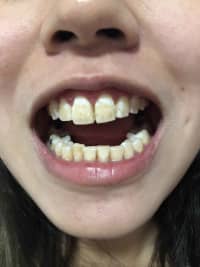Your upper front teeth appear to be straight but the edges are not even. This may give rise to the perception that the teeth are not straight EVEN if the root axes (how the roots appear on xray, and correctly placed braces will tend to make the roots of your teeth parallel) have been properly aligned. This is usually diagnosed pre-treatment. When you have crowding, the edges of the teeth tend to wear down in an irregular way but this may not be obvious when the teeth have not yet been straightened out. You may choose to either accept this irregular appearance or even out the edges by polishing (enameloplasty) or adding to the worn down edges.
From the photos, I can see that the lower front teeth still appear to be slightly crooked. I don't see any gaps, unless they are present further back.
I feel that you would benefit from either:
1) Restarting a short course of braces to finish and detail the final tooth positions.
2) Changing to Invisalign, which will do the same thing as braces but is more costly.
3) Accept the lower alignment and try to improve the appearance of the upper front teeth with edge bonding, enameloplasty or veneers.






